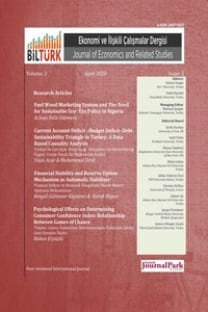Obesity and Economic Growth: An Analysis for Organisation of Islamic Cooperation Members: A Comparison between Africa and Eastern Mediterranean Regions
The increasing global trend in obesity rates is mainly linked to various social, economic, and medical determinants. Besides economic growth being named in the literature as one of the main motivations that trigger people to gain weight, culture-based motivations might also impact obesity. Although Islam suggests a healthy lifestyle and disciplined eating behaviour, many Islamic countries face high obesity rates. Using the fixed effects model, we examined the relationship between obesity rates and economic growth in the context of the Obesity Kuznets Curve Model by comparing the Organisation of Islamic Cooperation member countries in Africa and Eastern Mediterranean regions for the years between 1975 and 2016. We also estimated a second model for Africa by comparing the Organisation of Islamic Cooperation members and other countries outside the organisation. The results show that Obesity Kuznets Curve Model is valid for both Organisation of Islamic Cooperation members in Africa and the Eastern Mediterranean. On the other hand, the impact of economic growth is insignificant for the countries outside of the organisation in Africa if the economy continues to grow.
Anahtar Kelimeler:
Obesity rates, economic growth, Organisation of Islamic Cooperation, Obesity Kuznets Curve model
Obesity and Economic Growth: An Analysis for Organisation of Islamic Cooperation Members: A Comparison between Africa and Eastern Mediterranean Regions
The increasing global trend in obesity rates is mainly linked to various social, economic, and medical determinants. Besides economic growth being named in the literature as one of the main motivations that trigger people to gain weight, culture-based motivations might also impact obesity. Although Islam suggests a healthy lifestyle and disciplined eating behaviour, many Islamic countries face high obesity rates. Using the fixed effects model, we examined the relationship between obesity rates and economic growth in the context of the Obesity Kuznets Curve Model by comparing the Organisation of Islamic Cooperation member countries in Africa and Eastern Mediterranean regions for the years between 1975 and 2016. We also estimated a second model for Africa by comparing the Organisation of Islamic Cooperation members and other countries outside the organisation. The results show that Obesity Kuznets Curve Model is valid for both Organisation of Islamic Cooperation members in Africa and the Eastern Mediterranean. On the other hand, the impact of economic growth is insignificant for the countries outside of the organisation in Africa if the economy continues to grow.
Keywords:
Obesity rates, economic growth, Organisation of Islamic Cooperation, Obesity Kuznets Curve model,
___
- Ameye, H. and Swinnen, J. (2019). Obesity, income and gender: The changing global relationship. Global Food Security, 23, 267-281.
- Aydın, M. (2019). The effect of economic growth on obesity for the most obese countries: new evidence from the obesity Kuznets curve. The European Journal of Health Economics. 20, 1349-1358.
- Bai, J. and Ng, S. (2001). A PANIC Attack on Unit Roots and Cointegration, mimeo, Boston College, Department of Economics.
- Egger, G., Swinburn, B. and Islam, F.M.A. (2012). Economic growth and obesity: An interesting relationship with world-wide implications. Economics and Human Biology. 10, 2, 147- 153.
- Fox, A., Feng, W. and Asal, V. (2019). What is driving global obesity trends? Globalization or “modernization”?. Globalization and Health. 15, 32, 1-16.
- Goryakin, Y. and Suchrke, M. (2014). Economic development, urbanization, technological change and overweight: What do we learn from 244 Demographic and Health Surveys?. Economics and Human Biology. 14, 109-127.
- Gortmaker, S., Kawachi, I., Neuman, M. and Subramanian, S. (2014). National economic development and disparities in body mass index: A cross-sectional study of data from 38 countries. PLoS One. 9, 6, e99327.
- Grecu, A.M. and Rotthoff, K.W. (2015). Economic growth and obesity: findings of an Obesity Kuznets curve. Applied Economics Letter. 22, 7, 539- 543.
- Iftikhar, R. Albar M. and Qadi, M. (2016). Obesity and Lifestyle Recommendations in the Light of Islam. Journal of Family Medicine and Disease Prevention. 2, 034.
- Lawson, R.A., Murphy, R.H. and Williamson, C.R. (2016). The relationship between income, economic freedom, and BMI. Public Health. 134, 18-25.
- McCarthy, M. (2004). The Economics of Obesity. The Lancet World Report. 364, 9452, 2169-2170.
- Musaiger A.O. (1994). Nutritional status and dietary habits of adolescent giirls in Oman. Ecol Food Nutr. 31, 227-237.
- Organisation of Islamic Cooperation. (2022). Members. https://www.oic-oci.org/states/?lan=en
- Organization of the Petroleum Exporting Countries. (2022). Data/ Graphs. https://www.opec.org/opec_web/en/data_graphs/330.htm
- Pisa, P.T. and Pisa, N.M. (2016). Economic growth and obesity in South African adults: an ecological analysis between 1994 and 2014. The European Journal of Public Health. 27, 3, 404- 409.
- Talukdar, D., Seenivasan, S., Cameron, A.J. and Sacks, G. (2020). The association between national income and adult obesity prevalence: Empirical insights into temporal patterns and moderators of the association using 40 years of data across 147 countries. PLoS One. 15, 5, e0232236.
- Templin, T., Hashiguchi, T.C.O., Thomson, B., Dieleman, J. and Bendavid, E. (2019). The overweight and obesity transition from the wealthy to the poor in low-and middle-income countries: A survey of household data from 103 countries. PLoS Med. 16, 11, e1002968.
- Windarti, N., Hlaing, S.W., and Kakinaka, M. (2019). Obesity Kuznets curve: international evidence. Public Health. 169, 26-35.
- World Bank. (2022). Data. https://data.worldbank.org/indicator/NY.GDP.PCAP.KD?view=chart
- World Health Organization (2022). The Global Health Observatory. https://www.who.int/data/gho/data/indicators/indicator-details/GHO/prevalence-of-obesity-among-adults-bmi-=-30-(age-standardized-estimate)-(-)
- Yayın Aralığı: Yılda 4 Sayı
- Başlangıç: 2019
- Yayıncı: Fatih DEYNELİ
